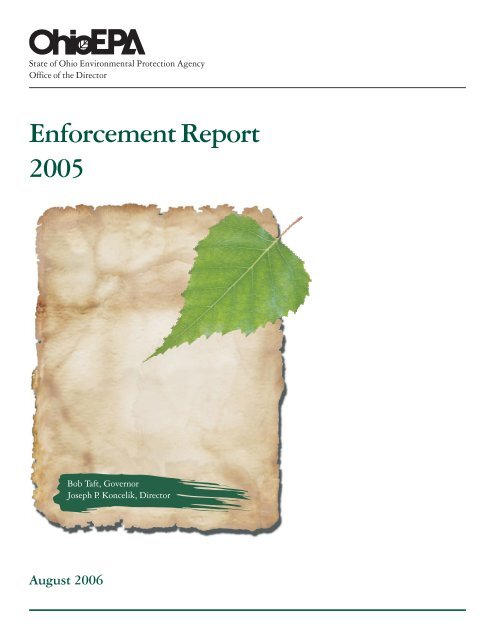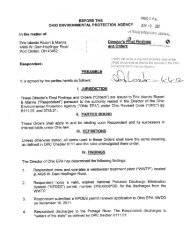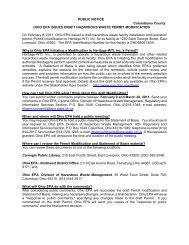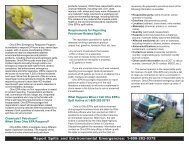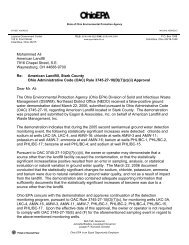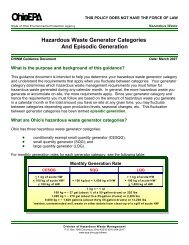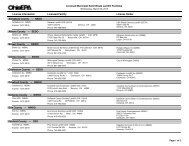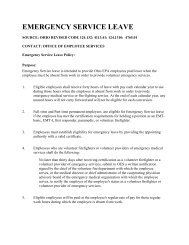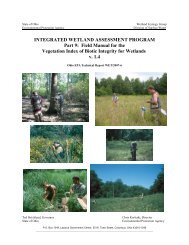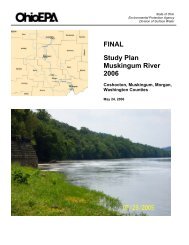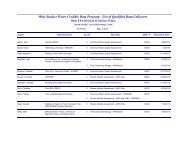Enforcement Report 2.pmd - Ohio EPA
Enforcement Report 2.pmd - Ohio EPA
Enforcement Report 2.pmd - Ohio EPA
Create successful ePaper yourself
Turn your PDF publications into a flip-book with our unique Google optimized e-Paper software.
State of <strong>Ohio</strong> Environmental Protection Agency<br />
Office of the Director<br />
<strong>Enforcement</strong> <strong>Report</strong><br />
2005<br />
Bob Taft, Governor<br />
Joseph P. Koncelik, Director<br />
August 2006
Introduction<br />
This is <strong>Ohio</strong> <strong>EPA</strong>’s sixth annual enforcement report.<br />
It highlights achievements in the Agency’s enforcement<br />
program in 2005, both in terms of performance and<br />
environmental benefits.<br />
A large number of cases were resolved in a timely<br />
fashion, making 2005 another successful year. In addition<br />
to resolving violations, these actions will result in significant<br />
environmental improvements. <strong>Ohio</strong> <strong>EPA</strong> also began<br />
to implement the Clean Diesel School Bus Program.<br />
Using a portion of civil penalties collected, <strong>Ohio</strong> <strong>EPA</strong><br />
provides grants to school districts to put pollution control<br />
equipment on their diesel buses. This reduces particulate<br />
emissions, leading to cleaner air and a more healthy<br />
environment for students.<br />
Acknowledgment is due to the inspectors,<br />
enforcement coordinators and attorneys at <strong>Ohio</strong> <strong>EPA</strong><br />
and the <strong>Ohio</strong> Attorney General’s Office who make these<br />
accomplishments possible.<br />
Improved Management of the<br />
Agency’s <strong>Enforcement</strong> Program<br />
<strong>Ohio</strong> <strong>EPA</strong> has been engaged in an ongoing effort to<br />
improve its enforcement program since 1999. A number<br />
of changes are documented in this and prior enforcement<br />
reports. The major changes include:<br />
• establishment of Agency-wide performance standards;<br />
• full reviews of all six major enforcement programs;<br />
• paperwork reductions;<br />
• development of standard legal orders and streamlined<br />
enforcement protocols;<br />
• clarification of enforcement roles and responsibilities;<br />
and<br />
• enhanced enforcement training in some programs.<br />
2005 <strong>Enforcement</strong> <strong>Report</strong> - page 1<br />
Because of these efforts, <strong>Ohio</strong> <strong>EPA</strong> has significantly<br />
improved the overall management of the Agency’s<br />
enforcement program. These improvements include:<br />
• a 46 percent increase in the number of administrative<br />
orders issued;<br />
• a 49 percent increase in yearly average administrative<br />
penalties assessed;<br />
• a significant reduction in old cases (110 cases older<br />
than 24 months in 1999; 3 cases older than 21 months<br />
at the end of 2005); and<br />
• a drop in the average age of administrative enforcement<br />
cases on the docket from 475 days in 1999 to 241 days<br />
in 2005.<br />
We continue to examine the enforcement program<br />
and look for ways to build upon these improvements and<br />
obtain more benefit to the environment.<br />
2005 Case Highlight<br />
Protecting Public Health<br />
In October 2005, the director ordered Rutgers<br />
Organics to clean up sources of ground water<br />
contamination at the Paddy’s Run Road site,<br />
near Fernald. The goal is to prevent vapors from<br />
underground contamination from entering nearby<br />
homes. Sampling showed the presence of benzene,<br />
xylene, arsenic and other pollutants. <strong>Ohio</strong> <strong>EPA</strong><br />
continues to work toward a long-term resolution<br />
that will ensure the protection of area residents.
2005 <strong>Enforcement</strong><br />
Highlights<br />
• <strong>Ohio</strong> <strong>EPA</strong> issued 176 enforcement orders in 2005,<br />
surpassing its goal of 133 by 32 percent.<br />
• Significant improvements to the environment will be<br />
achieved including: 1,011 tons of air pollution<br />
eliminated; 9,053 customers with cleaner drinking<br />
water; 1,901,033 million gallons per day of<br />
wastewater receiving enhanced treatment; 5,762,636<br />
abandoned scrap tires removed; 123.75 tons of<br />
hazardous waste properly disposed; and 28 acres of<br />
contaminated property cleaned up and put back into<br />
productive use.<br />
• The Agency assessed $2,906,080 in administrative<br />
penalties.<br />
• Civil penalties awarded in civil judgements or secured<br />
in consent decrees by the Attorney General’s Office<br />
totaled $22,574,389, which includes a $20 million<br />
civil penalty award in a single case, Kirby Tire.<br />
• The criminal environmental enforcement program<br />
secured 34 convictions or plea agreements with 42<br />
felonies and 16 misdemeanors. These efforts resulted in<br />
more than $577,184 in fines and restitution.<br />
• The Division of Surface Water issued 42 orders and<br />
assessed administrative penalties of $512,098.<br />
• The Division of Air Pollution Control issued 63 orders,<br />
surpassing its goal of 45 orders by 40 percent.<br />
• The Division of Hazardous Waste Management issued<br />
25 orders, exceeding its goal by 25 percent. A<br />
review of the division’s enforcement program resulted<br />
in a more streamlined program.<br />
• The Division of Solid and Infectious Waste Management<br />
issued 20 orders, exceeding its goal by four.<br />
2005 <strong>Enforcement</strong> <strong>Report</strong> - page 2<br />
• The Division of Drinking and Ground Waters issued<br />
21 orders, exceeding its goal by 50 percent. The<br />
division also addressed compliance issues at 15 public<br />
water systems with bilateral compliance agreements.<br />
• The Division of Emergency and Remedial Response<br />
issued four orders that will result in 28 acres being<br />
remediated and obtained $1,105,690 in recovered<br />
costs for investigative cleanups.<br />
2005 Case Highlight<br />
Protecting <strong>Ohio</strong>’s Waterways and<br />
Cleaning Up Hazardous Waste<br />
P&J Industries, of Toledo, operates a zinc<br />
and zinc-nickle automotive parts electroplating<br />
business and a chrome and chrome-nickle plating<br />
business. After Toledo’s Division of Environmental<br />
Services (Toledo DES) reported a yellow precipitate in<br />
Shantee Creek in 2004, <strong>Ohio</strong> <strong>EPA</strong> and Toledo DES<br />
traced the source of the material to P&J Industries’<br />
facility. A roll-off container was leaking waste into a<br />
storm drain that discharged into the creek. The<br />
company cleaned the drain, creek and creek bank.<br />
During a follow-up inspection, <strong>Ohio</strong> <strong>EPA</strong> found<br />
a number of hazardous waste violations, including<br />
disposing hazardous waste into Shantee Creek<br />
without a permit, storing hazardous waste without a<br />
permit and failing to evaluate some waste to determine<br />
if it was hazardous.<br />
P&J Industries agreed to pay a total of $90,000<br />
in civil penalties for hazardous waste, surface water<br />
discharges and toxic release reporting violations.<br />
Portions of the penalty money are going toward<br />
specific environmental improvements. <strong>Ohio</strong> <strong>EPA</strong>’s<br />
Clean Diesel School Bus Program fund will receive<br />
$24,400 and the Maumee Remedial Action Plan<br />
(Maumee RAP) program will receive $11,600 from<br />
the surface water settlement to help pay for the<br />
group’s efforts to improve area waterways.
Environmental Improvements<br />
Achieved Through<br />
<strong>Enforcement</strong> in 2005<br />
One goal of <strong>Ohio</strong> <strong>EPA</strong>’s enforcement program is to<br />
bring facilities back into compliance to ensure that public<br />
health, safety and the environment are protected. As in<br />
years past, <strong>Ohio</strong> <strong>EPA</strong>’s enforcement efforts in 2005<br />
resulted in improvements to <strong>Ohio</strong>’s air, water, land and<br />
overall protection of public health.<br />
Cleaner Air<br />
Many enforcement actions taken by the Division of<br />
Air Pollution Control result in decreased levels of air<br />
pollutants. Because each action resulted in the installation<br />
or proper operation of permanent air pollution<br />
controls, the reductions achieved this year and in prior<br />
years will benefit the environment for many years. <strong>Enforcement</strong><br />
cases settled in 2005 will result in a reduction<br />
of more than 1,000 tons of air pollution, as shown below.<br />
Air Pollution Reduced due to <strong>Enforcement</strong><br />
• Volatile organic compounds - 426 tons per year<br />
• Particulates - 159 tons per year<br />
• NOx - 425 tons per year<br />
• HCl - 0.79 tons per year<br />
TOTAL - 1,010,79 tons per year<br />
Cleaner Drinking Water<br />
The Division of Drinking and Ground Waters<br />
regulates public water systems. <strong>Enforcement</strong> actions are<br />
taken against a variety of drinking water providers –<br />
from major municipalities to small mobile home parks –<br />
to ensure that they provide adequately treated drinking<br />
water. The chart below shows the number of citizens who<br />
have cleaner drinking water as a result of <strong>Ohio</strong> <strong>EPA</strong>’s<br />
enforcement actions.<br />
Citizens with Cleaner Drinking Water<br />
4,338 customers - 2001<br />
9,208 customers - 2002<br />
8,947 customers - 2003<br />
4,789 customers - 2004<br />
9,053 customers - 2005<br />
2005 <strong>Enforcement</strong> <strong>Report</strong> - page 3<br />
Protecting <strong>Ohio</strong>’s Streams, Lakes Rivers and<br />
Wetlands<br />
The Division of Surface Water protects <strong>Ohio</strong>’s<br />
streams, rivers, lakes and wetlands. <strong>Enforcement</strong> actions<br />
range from eliminating sewage overflows from large<br />
municipal wastewater collection systems to addressing<br />
storm water requirements at construction sites. The<br />
statistics below demonstrate improvements to <strong>Ohio</strong>’s<br />
waterways:<br />
• Sewer overflows addressed: 12<br />
• Illicit discharges addressed: 3<br />
• Spill/releases addressed: 203,100 gallons<br />
• Wastewater flow abandoned/tied into regional<br />
treatment plant: 18,700 gallons per day<br />
• Wastewater receiving enhanced treatment:<br />
1,901,033 million gallons per day<br />
• Improved storm water controls: 926 acres<br />
• Failing on-lot systems addressed: 2,398 lots<br />
Cleaner Land<br />
The Division of Solid and Infectious Waste Management<br />
cleans up open dumps and abandoned tires and<br />
regulates composting, solid waste, construction and<br />
demolition debris, and infectious waste facilities. Below<br />
are statistics regarding the amount of waste and tires<br />
removed from open dumps in <strong>Ohio</strong> in 2005:<br />
• Abandoned scrap tires cleaned up: 5,762,636<br />
• Construction and demolition debris removed from<br />
open dumps: 7,673 cubic yards
The Division of Hazardous Waste Management<br />
ensures the proper management, transportation and<br />
disposal of hazardous waste. <strong>Enforcement</strong> actions are<br />
taken to ensure proper closure of hazardous waste units.<br />
Each year, the division certifies that these closures have<br />
been properly completed. The amount of hazardous waste<br />
addressed through closure certifications in 2005 is shown<br />
below.<br />
• Contaminated soil removed and disposed through<br />
hazardous waste cleanups: 63.44 tons<br />
• Contaminated surface water and wastewater<br />
collected and removed for proper disposal:<br />
28,785 gallons<br />
• Hazardous waste properly disposed: 123.75 tons<br />
• Hazardous liquid waste removed and properly<br />
disposed: 1,330 gallons<br />
• Non-hazardous waste removed and properly<br />
disposed: 600.6 tons<br />
• Decrease in hazardous waste generated by year:<br />
55 tons per year.<br />
The Division of Emergency and Remedial Response<br />
takes enforcement actions to prompt cleanups at sites in<br />
<strong>Ohio</strong> where hazardous substances were disposed of long<br />
ago before environmental regulations existed. These sites<br />
are often the most complex or costly to clean up. In 2005,<br />
the division issued enforcement actions that will result in<br />
28 acres of <strong>Ohio</strong> land being returned to productive use.<br />
2005 Case Highlight<br />
Protecting Public Health and Safety<br />
On September 1, 2005, the Village of<br />
Lawrenceville filed paperwork with the clerk of<br />
courts to dissolve the Village. As part of the dissolution,<br />
the Village ceased to provide water to the<br />
residents and no longer had an operator running the<br />
public water system. <strong>Ohio</strong> <strong>EPA</strong> determined that an<br />
emergency existed and used the provisions in <strong>Ohio</strong><br />
law to order Clark County to run the water system.<br />
The emergency orders remained in effect for the<br />
maximum 90 days set forth in the statute. <strong>Ohio</strong><br />
<strong>EPA</strong> has remained in communication with Clark<br />
County regarding their continued operation of the<br />
public water system under more traditional orders.<br />
2005 <strong>Enforcement</strong> <strong>Report</strong> - page 4<br />
2005 Case Highlight<br />
Environmental Improvement<br />
through Criminal <strong>Enforcement</strong><br />
of Environmental Laws<br />
Green Circle Growers is <strong>Ohio</strong>’s largest greenhouse<br />
with more than 20 million square feet of<br />
greenhouse space. It historically discharged untreated<br />
and unpermitted wastewater into the East<br />
Fork of the Vermillion River. This wastewater<br />
contained a variety of pollutants including pesticides,<br />
herbicides and fertilizers.<br />
This problem went undetected until July 2002<br />
when <strong>Ohio</strong> <strong>EPA</strong> biologists were conducting a<br />
stream survey. They noticed the section of river that<br />
runs through the company’s property was almost<br />
devoid of fish and aquatic insects. Furthermore,<br />
the numbers and types of fish and aquatic insects<br />
were negatively affected several miles downstream<br />
from the greenhouse. <strong>Ohio</strong> <strong>EPA</strong>, BCI and U.S.<br />
<strong>EPA</strong> began a criminal investigation.<br />
In February 2005, Green Circle Growers pled<br />
to an illegal discharge and was fined $50,000. In<br />
addition, the company was ordered to pay $50,000<br />
restitution to the Lorain County Soil and Water<br />
District; $30,000 restitution to <strong>Ohio</strong> <strong>EPA</strong> to fund<br />
a follow-up chemical and biological survey of the<br />
river; and $120,000 to fund a dam removal study<br />
on the upper Cuyahoga River.<br />
As a result of this case, GCG invested more<br />
than $1 million to improve its wastewater management.<br />
Results from <strong>Ohio</strong> <strong>EPA</strong>’s follow-up survey in<br />
2005 showed that the water quality is improving<br />
both near the company and downstream. The fish<br />
community is now at an acceptable level. Although<br />
still at an unacceptable level, there is improvement<br />
in the aquatic insect population.
DERR<br />
DDAGW<br />
DSIWM<br />
DHWM<br />
DSW<br />
DAPC<br />
<strong>Ohio</strong> <strong>EPA</strong> <strong>Enforcement</strong><br />
Goals for 2005<br />
The Agency established nine goals for the 2005<br />
enforcement program. A summary of results follows.<br />
Goal 1: Increase the measurements of<br />
enforcement efforts.<br />
Since 1999, we have used a number of measures to<br />
gauge the overall health of <strong>Ohio</strong> <strong>EPA</strong>’s enforcement<br />
program. These have included the number of orders<br />
issued and the number of consent decrees/judgements<br />
obtained by the <strong>Ohio</strong> Attorney General’s Office. While<br />
these are important measures of an enforcement program,<br />
a number of other activities should be acknowledged.<br />
For example, in 2005, <strong>Ohio</strong> <strong>EPA</strong>’s enforcement efforts<br />
involved:<br />
•11,281 compliance inspections;<br />
•4,848 complaint inspections; and<br />
•6,121 notice of violation letters.<br />
Goal 2: Resolve all administrative<br />
enforcement cases older than 21 months by<br />
the end of 2005.<br />
The performance standard was first used in 2004.<br />
In 2004, the standard was met for 82 percent of the cases.<br />
In 2005, the standard was met in an impressive 97<br />
percent of the cases.<br />
0<br />
3<br />
0<br />
4<br />
0<br />
10<br />
0<br />
8<br />
3<br />
18<br />
0<br />
53<br />
0 10 20 30 40 50 60<br />
Old Cases<br />
at start of 2005<br />
96<br />
2005 <strong>Enforcement</strong> <strong>Report</strong> - page 5<br />
Goal 2: Resolve all administrative<br />
cases that will be 21 months<br />
old by end of 2005.<br />
Old Cases at<br />
end of 2005<br />
3<br />
Total Referrals<br />
Average number of days<br />
100<br />
80<br />
60<br />
40<br />
20<br />
0<br />
300<br />
250<br />
200<br />
150<br />
100<br />
50<br />
0<br />
87<br />
66<br />
61<br />
51<br />
62<br />
AGO Referrals<br />
1996 1997 1998 1999 2000 2001 2002 2003 2004 2005<br />
DAPC DSW DSIWM DHWM DDAGW Total<br />
Goal 3: Resolve all verified complaints within<br />
two years of receipt.<br />
<strong>Ohio</strong> <strong>EPA</strong> met this performance standard with the<br />
exception of one case. That case was resolved in principle<br />
within two years, but the official approval from the local<br />
governmental entity did not occur until shortly after the<br />
two-year time period had ended.<br />
58<br />
55<br />
Age of Administrative Cases at<br />
Beginning and End of 2005<br />
Beginning 2005 End 2005<br />
42<br />
36<br />
56
25<br />
20<br />
15<br />
10<br />
5<br />
0<br />
23<br />
21<br />
1999 2000 2001 2002 2003 2004 2005<br />
Goal 4: Issue 133 orders in 2005.<br />
In 2005, the Agency issued 176 orders, exceeding its<br />
goal by 32 percent.<br />
70<br />
60<br />
50<br />
40<br />
30<br />
20<br />
10<br />
0<br />
111<br />
63<br />
45<br />
42<br />
2005 <strong>Enforcement</strong> <strong>Report</strong> - page 6<br />
Pending Verified<br />
Complaints<br />
Older Than Two Years<br />
2 2 0 0 1<br />
Goal: Issue 133 Orders in 2005<br />
33<br />
21<br />
16<br />
DAPC DSW DSIWM DHWM DDAGW DERR<br />
Agency Total: Goal: 133 Issued: 176<br />
25<br />
20<br />
21<br />
Goal Orders Issued<br />
Administrative Orders Issued<br />
and Associated Penalties<br />
1996-2005<br />
83 80 82<br />
$1,591,108<br />
$1,217,980<br />
$1,201,789<br />
$1,109,113<br />
103<br />
$2,286,762<br />
4<br />
146 144 140<br />
$2,189,589<br />
$2,164,365<br />
$2,543,874<br />
14<br />
214<br />
$4,231,763<br />
96 97 98 99 00 01 02 03 04 05<br />
5<br />
176<br />
$2,906,080<br />
total number of cases<br />
70<br />
60<br />
50<br />
40<br />
30<br />
20<br />
10<br />
140<br />
120<br />
100<br />
0<br />
80<br />
60<br />
40<br />
20<br />
0<br />
127<br />
82<br />
6<br />
3 4 4<br />
1 0<br />
3<br />
6<br />
18<br />
63<br />
11<br />
<strong>Enforcement</strong> Docket Sizes<br />
at Beginning and End of 2oo5<br />
42<br />
21 10<br />
19<br />
60<br />
DAPC DSW DSIWM DHWM DDAGW DERR<br />
Admin. Cases<br />
beginning 2005<br />
8<br />
0<br />
44 39<br />
69<br />
7<br />
<strong>Enforcement</strong> Action Requests<br />
by District in 2oo5<br />
17<br />
27<br />
24 24<br />
21<br />
Admin. Cases<br />
end 2005<br />
4 5 6<br />
1<br />
40<br />
31 34 34 29<br />
5 811 9<br />
5<br />
0<br />
AGO Cases<br />
beginning 2005<br />
CDO NEDO NWDO SEDO SWDO CO<br />
Goal 5: Track agency performance standards<br />
established to meet the five-year statute of<br />
limitations on enforcement cases.<br />
In 2002, the <strong>Ohio</strong> General Assembly enacted a fiveyear<br />
statute of limitations on environmental violations for<br />
which <strong>Ohio</strong> <strong>EPA</strong> will be seeking a civil penalty. To ensure<br />
that the we bring enforcement actions within this requirement,<br />
we developed performance standards for cases in<br />
which we are seeking a civil penalty. We began officially<br />
implementing these performance standards in 2005.<br />
A key date under the statute is July 2007. This is<br />
the earliest date that the statute of limitations applies to<br />
violations that existed prior to the enactment of<br />
legislation.<br />
At the beginning of 2005, we had 121 cases either<br />
at <strong>Ohio</strong> <strong>EPA</strong> or the Attorney General’s Office where at<br />
least some of the violations at issue were subject to a<br />
statute of limitation in July 2007. At the end of 2005, 95<br />
38<br />
1<br />
9<br />
1 4<br />
0 2<br />
17<br />
11<br />
AGO Cases<br />
end 2005<br />
21<br />
8<br />
4<br />
0 0<br />
DAPC DSW DSIWM DHWM DDAGW DERR TOTAL<br />
49<br />
63<br />
4 5<br />
12 13<br />
6 5<br />
44
cases remained that either had not been settled or where a<br />
complaint had not been filed. To avoid issues with the<br />
statute of limitations, we will resolve these cases or file<br />
complaints in these 95 cases by July 2007.<br />
Goal 6: Improve tracking compliance with<br />
existing orders and judicial consent decrees.<br />
Since 2000, <strong>Ohio</strong> <strong>EPA</strong> has issued 919 enforcement<br />
orders. During that same period, the Attorney General’s<br />
Office has obtained 282 judgements/consent decrees.<br />
In most cases, defendants/respondents comply with the<br />
obligations they have agreed to or have been ordered to<br />
perform. However, in some cases they do not.<br />
Historically, <strong>Ohio</strong> <strong>EPA</strong>’s divisions have varied in<br />
how they tracked compliance with orders/consent decrees.<br />
In some cases, central office tracked progress while in<br />
others it was assigned to a district inspector. On occasion,<br />
vagueness in either who should be tracking progress or<br />
how to communicate problems encountered has led to<br />
delays in addressing noncompliance.<br />
To improve our performance in this area, the Agency<br />
developed a draft protocol between <strong>Ohio</strong> <strong>EPA</strong> and the<br />
Attorney General’s Office. It establishes expectations and<br />
processes regarding tracking and addressing noncompliance<br />
with orders/consent decrees. We will finalize the<br />
document in 2006.<br />
Goal 7: Develop supplemental environmental<br />
project (SEP) for diesel bus initiative.<br />
Many counties in <strong>Ohio</strong> do not meet the national<br />
air quality standard for fine particulates (particles less<br />
than 2.5 microns in diameter). These small particulates<br />
penetrate deep into the lungs and pose serious health<br />
risks such as aggravated asthma and lung damage.<br />
The exhaust gases from diesel school bus engines contain<br />
significant amounts of these fine particulates.<br />
In 2005, we developed and began implementing an<br />
initiative to provide funding to school systems so they can<br />
install diesel particulate controls on school buses. The<br />
grants are funded by a portion of the civil penalty dollars<br />
collected for environmental violations. This effort required<br />
us to adopt administrative rules. (In June 2006, <strong>Ohio</strong><br />
<strong>EPA</strong> awarded the first grants under this program in the<br />
amount of $424,157 to nine school districts for retrofitting<br />
238 buses.)<br />
2005 <strong>Enforcement</strong> <strong>Report</strong> - page 7<br />
Goal 8: Develop uniform agency SEP policy.<br />
In 2005, we circulated and obtained comments<br />
from Agency staff on a uniform policy for supplemental<br />
environmental projects. The purpose of the policy is to<br />
provide more consistency among programs in how we<br />
incorporate these projects into enforcement settlements.<br />
We had hoped to develop the final policy by the end of<br />
2005. However, work continues on blending internal<br />
comments among the divisions. We will adopt a final<br />
policy by the end of 2006.<br />
Goal 9: Complete enforcement program<br />
review in the Division of Hazardous Waste<br />
Management.<br />
In 2005, we completed an intensive review of the<br />
Division of Hazardous Waste Management enforcement<br />
program. This was the last division to undergo this<br />
review. As a result of this process, DHWM will implement<br />
two recommendations designed to increase the<br />
speed with which the division resolves cases. These<br />
include streamlining the enforcement referral form and<br />
developing “Fast Track” referrals for certain types of<br />
enforcement actions. Because of the anticipated benefits of<br />
these improvements, the division’s goal for completed<br />
orders for 2006 has been increased from 20 to 25 cases.<br />
2005 Case Highlight<br />
Protecting <strong>Ohio</strong>’s Air<br />
The Longaberger Company owns and operates<br />
a facility in Hartville that produces wood used at<br />
the company’s decorative wooden basket manufacturing<br />
facilities. The Hartville facility uses a waste<br />
wood-fired boiler to generate steam for space<br />
heating and industrial processing.<br />
Tests performed at the facility showed the<br />
boiler emitted more particulate emissions than<br />
allowed. Under orders issued by <strong>Ohio</strong> <strong>EPA</strong>,<br />
Longaberger made improvements that brought the<br />
boiler back into compliance. As a result, particulate<br />
emissions are down about 12.6 tons per year. This<br />
is particularly important because the facility is in a<br />
county that does not meet federal air quality<br />
standards for particulate matter. The orders also<br />
assessed a civil penalty of $39,200.
Overall Status of <strong>Ohio</strong> <strong>EPA</strong>’s<br />
<strong>Enforcement</strong> Programs<br />
Criminal <strong>Enforcement</strong><br />
<strong>Ohio</strong> <strong>EPA</strong> and the Attorney General’s Office<br />
continue to be recognized for having one of the best<br />
criminal environmental enforcement programs in the<br />
country. In 2005, they secured or assisted in securing<br />
convictions in the following areas:<br />
Convictions Pleas Felonies Misdemeanors<br />
Drinking Water 1 1 0<br />
Air 2 1 1<br />
Solid Waste 6 2 7<br />
Hazardous Waste 14 8 7<br />
Surface Water 11 30 1<br />
Total 34 42 16<br />
These convictions and plea agreements resulted in<br />
punishments including 1,290 days of jail time; 480 days<br />
of home incarceration; 1,770 hours of community service;<br />
and $577,184 in fines and restitution.<br />
Attorney General’s Office<br />
The Attorney General’s Office obtained judgments<br />
or consent decrees in 30 cases and assessed $22,574,389<br />
in civil penalties in 2005. This figure includes a<br />
$20 million civil penalty awarded in the Kirby Tire case.<br />
This is one of the largest civil penalty awards in <strong>Ohio</strong> for<br />
environmental violations. The Attorney General’s Office<br />
also secured $20,747,342 in restitution/response costs in<br />
five cases including $19,257, 674 in the Kirby case.<br />
Administrative <strong>Enforcement</strong><br />
<strong>Ohio</strong> <strong>EPA</strong> issued 176 orders and assessed<br />
$2,906,080 in administrative penalties (cash plus<br />
supplemental environmental projects) in 2005.<br />
2005 <strong>Enforcement</strong> <strong>Report</strong> - page 8<br />
Division of Air Pollution Control<br />
The Division of Air Pollution Control continues to<br />
have the busiest enforcement program in the Agency. The<br />
division issued 63 orders and obtained 10 consent orders/<br />
judgements. The division assessed total penalties of<br />
$2,338,006 ($1,117,812 by the AGO and $1,220,194<br />
in administrative penalties). In 2005, division staff, along<br />
with the Office of Environmental Education, were instrumental<br />
in shaping the Clean Diesel School Bus Program.<br />
The division continued to carry the largest enforcement<br />
docket of all <strong>Ohio</strong> <strong>EPA</strong> divisions with 82 administrative<br />
cases and 63 cases at the Attorney General’s Office at the<br />
end of 2005.<br />
Division of Surface Water<br />
The Division of Surface Water maintained its high<br />
productivity in 2005. It issued 42 orders, exceeding its<br />
goal by 9 orders or 27 percent. This is the second highest<br />
number of orders issued by <strong>Ohio</strong> <strong>EPA</strong> divisions. The<br />
division also accepted 80 new enforcement referrals in<br />
2005, the highest of any division. DSW assessed total<br />
penalties of $1,508,598 ($996,500 by the AGO and<br />
$512,098 in administrative penalties).<br />
Division of Hazardous Waste Management<br />
The Division of Hazardous Waste Management<br />
issued 25 orders, exceeding its goal by five. The division<br />
assessed $951,497 in civil penalties ($307,077 by the<br />
AGO and $644,420 in administrative penalties) and<br />
recovered $10,000 in restitution/response costs. The<br />
hazardous waste program leads the Agency in the<br />
timeliness of enforcement action requests sent from<br />
district offices and beginning negotiation with the<br />
involved parties relative to the date of violation.
AGO Orders Issued and Associated Penalties<br />
1996-2005<br />
48<br />
$4,475,685<br />
51 49<br />
$9,653,956<br />
57<br />
$3,822,844<br />
44<br />
$4,618,323<br />
$3,042,140<br />
54 53<br />
$5,958,717<br />
96 97 98 99 00 01 02 03 04 05<br />
Division of Solid and Infectious<br />
Waste Management<br />
The Division of Solid and Infectious Waste Management<br />
issued 20 orders in 2005, exceeding its goal by four.<br />
The division assessed or was awarded $20,223,468 in<br />
civil penalties ($20,060,000 by the AGO and $163,468<br />
in administrative penalties). The $20,000,000 civil<br />
penalty was awarded in the Kirby Tire case. The court<br />
also ordered restitution in the amount of $19,257,674.<br />
Division of Drinking and<br />
Ground Waters<br />
The Division of Drinking and Ground Waters issued<br />
21 orders in 2005, exceeding its goal by seven, and<br />
assessed $365,900 in penalties. The division also entered<br />
into 15 bilateral compliance agreements. These agreements<br />
address violations that are serious but able to be<br />
corrected without administrative orders.<br />
2005 <strong>Enforcement</strong> <strong>Report</strong> - page 9<br />
58<br />
$7,608,187<br />
$5,454,225<br />
46<br />
$15,681,641<br />
33 27<br />
$22,574,389<br />
(includes $20,000,000<br />
in civil penalties on Kirby case)<br />
Division of Emergency and Remedial<br />
Response<br />
Several years ago, the Division of Emergency and<br />
Remedial Response made a strategic decision to focus on<br />
a select number of priority sites in order to move those<br />
sites through the lengthy process toward final cleanup.<br />
This has been a successful effort for the division. Four<br />
orders were completed in 2005, one short of its goal.<br />
These orders will result in 28 acres being remediated and<br />
put back into productive use. The Attorney General’s<br />
Office also secured $1,105,690 in costs incurred in<br />
investigating contaminated sites.<br />
2005 Case Highlight<br />
Ensuring Proper Disposal of Waste<br />
Kirby Tire Recycling has a long history with<br />
<strong>Ohio</strong> <strong>EPA</strong>’s enforcement program. When <strong>Ohio</strong><br />
<strong>EPA</strong> and the Attorney General’s Office began<br />
formal enforcement action against the company in<br />
the mid 1990s, it was one of the nation’s largest<br />
unlawful accumulation of scrap tires. Located in<br />
Sycamore, the 110-acre site at one time contained<br />
an estimated 16 to 20 million scrap tires.<br />
<strong>Ohio</strong> <strong>EPA</strong> issued orders and obtained court<br />
judgements against the company that required the<br />
removal of tires and compliance with <strong>Ohio</strong>’s scrap<br />
tire requirements. When the company failed to<br />
comply, <strong>Ohio</strong> <strong>EPA</strong> mobilized a state-funded<br />
contractor to remove the tires.<br />
In August 1999, vandals set a fire at the<br />
facility. The fire affected approximately 17.5 acres<br />
involving approximately 5 to 7 million tires. <strong>Ohio</strong><br />
<strong>EPA</strong> continues its removal action as well as remedial<br />
activities associated with the fire.<br />
In June 2005, the Court of Common Pleas<br />
ordered a number of individuals associated with<br />
the facility to begin serving jail time for failing to<br />
comply with the Court’s contempt findings. And<br />
in October, the Court ordered Kirby to pay a $20<br />
million civil penalty. The company and Doris Kirby<br />
were ordered to reimburse the State $19,257,674<br />
in past and future response costs associated with the<br />
state-funded tire removal action and fire response costs.
<strong>Ohio</strong> <strong>EPA</strong> <strong>Enforcement</strong><br />
Goals for 2006<br />
Establishing goals and performance standards has<br />
positively impacted <strong>Ohio</strong> <strong>EPA</strong>’s enforcement program.<br />
Therefore, we will continue to implement them in 2006.<br />
By maintaining consistent goals, we can fairly measure<br />
our annual performance.<br />
Goal 1: Increase the measurements of<br />
enforcement efforts.<br />
2005 was the first year that we officially tracked and<br />
reported the number of inspections, complaints and notice<br />
of violation letters. These efforts paint a more comprehensive<br />
picture of <strong>Ohio</strong> <strong>EPA</strong>’s efforts to monitor and address<br />
compliance issues. We will continue tracking these items<br />
in 2006.<br />
Goal 2: Resolve all administrative<br />
enforcement cases older than 21 months<br />
by the end of 2006.<br />
This goal was established in 2004. In 2004, we met<br />
the standard 82 percent of the time. In 2005, we<br />
improved to 97 percent. In 2006, we will evaluate<br />
tightening this standard and making it fit well with<br />
other performance standards associated with the statute<br />
of limitations.<br />
Goal 3: Resolve all verified complaints within<br />
two years of receipt.<br />
We will continue to focus on meeting this performance<br />
standard in 2006. In 2005, we met it in all but<br />
one case.<br />
Goal 4: Issue 153 orders in 2006.<br />
In 2005, the Agency had a successful year and<br />
exceeded its goal of issuing 133 enforcement orders by<br />
32 percent. Therefore, the goal for 2006 is to issue 153<br />
orders. These are the specific targets for each division:<br />
DAPC (50); DSW (35); DHWM (25); DSIWM (20);<br />
DDAGW (18); and DERR (5).are the specific targets for<br />
each division: DAPC (50); DSW (35); DHWM (25);<br />
DSIWM (20); DDAGW (18); and DERR (5).<br />
2005 <strong>Enforcement</strong> <strong>Report</strong> - page 10<br />
Goal 5: Track Agency performance standards<br />
established to meet the five-year statute of<br />
limitations on enforcement cases.<br />
July 2007 is the first month that the statute of<br />
limitations will apply to environmental violations that<br />
took place prior to the enactment of the statute in 2002.<br />
The Agency has 95 cases currently in enforcement that<br />
could be affected. We will monitor these cases and take<br />
steps to resolve or file many of these cases in 2006.<br />
We will also continue to track our established<br />
performance standards in existing cases to ensure that we<br />
give the Attorney General enough time to resolve or file<br />
complaints within the statute of limitations.<br />
Goal 6: Improve tracking compliance with<br />
existing orders and judicial consent decrees.<br />
We will finalize the draft Memorandum of Understanding<br />
that we initiated in 2005 between <strong>Ohio</strong> <strong>EPA</strong><br />
and the Attorney General’s Office. A component will<br />
include new protocols on penalty payment tracking.<br />
2005 Case Highlight<br />
Pollution Prevention<br />
Albco, of Lisbon, produces yellow brass and<br />
zinc-aluminum castings for the steel industry. The<br />
manufacturing process generates a significant amount<br />
of hazardous waste. December 2002 inspection, <strong>Ohio</strong><br />
<strong>EPA</strong> found that the company was operating a hazardous<br />
waste storage facility without a permit, failing to<br />
properly train employees in hazardous waste management<br />
and failing to conduct and document inspections<br />
of emergency equipment and hazardous waste storage<br />
areas. All of the violations were corrected.<br />
As part of the settlement, Albco agreed to stop<br />
using leaded alloys in its brass castings operation. This<br />
change will reduce the company’s generation of leadcontaminated<br />
hazardous waste by 55 tons annually.<br />
For agreeing to invest in the non-lead alloys, $24,500<br />
of a $44,000 civil penalty was offset.
Goal 7: Finalize and implement a uniform<br />
Agency policy on supplemental<br />
environmental projects.<br />
In 2006, we will finalize the policy for Supplemental<br />
Environmental Projects and train staff on its implementation.<br />
2005 Case Highlight<br />
Criminal <strong>Enforcement</strong> of<br />
Environmental Laws<br />
After purchasing T & M Expressway Auto<br />
and Truck Parts, an automobile scrapyard, Thomas<br />
Chafin hired workers to clean up the property. They<br />
collected numerous drums containing waste antifreeze,<br />
oil, used fuel and a variety of unknown<br />
liquids. Chafin then paid James Bellomy, one of the<br />
workers who had helped with the cleanup, $620<br />
to dispose of the drums.<br />
In June 2004, an <strong>Ohio</strong> <strong>EPA</strong> investigator began<br />
receiving calls about abandoned drums in Mansfield.<br />
<strong>Ohio</strong> <strong>EPA</strong>, the Bureau of Criminal Identification<br />
and Investigations (BCI) and agents from U.S. <strong>EPA</strong><br />
began an investigation.<br />
A break in the case occurred when one of the<br />
individuals who had helped clean up the site called<br />
<strong>Ohio</strong> <strong>EPA</strong>. Those responsible admitted to dumping<br />
the drums at 12 locations in and around Mansfield.<br />
At one of the dump locations, a drum containing<br />
waste fuel leaked onto the ground. The fuel eventually<br />
made it to a nearby storm drain and then into<br />
the nearby stream. <strong>Ohio</strong> <strong>EPA</strong> responded and cleaned<br />
up the spill. In addition, <strong>Ohio</strong> <strong>EPA</strong> removed 43<br />
drums (many of which contained hazardous waste)<br />
from the 12 locations and properly disposed of them<br />
along with contaminated soil.<br />
Thomas Chafin pled to illegal disposal of<br />
hazardous waste and was sentenced to 90 days jail;<br />
$10,000 fine (suspended); $5,000 restitution; 200<br />
hrs of community service; and five years probation.<br />
James Bellomy pled to illegal disposal of hazardous<br />
waste and was sentenced to two years suspended<br />
jail; $2,000 restitution; 200 hrs of community<br />
service; and five years probation.<br />
2005 <strong>Enforcement</strong> <strong>Report</strong> - page 11<br />
2005 Case Highlight<br />
Multi-Media <strong>Enforcement</strong><br />
Columbus Steel Drum operates a drum<br />
reclamation and reconditioning facility in<br />
Gahanna. The company empties, flushes and<br />
incinerates wastes and residues in and on 55-gallon<br />
steel drums, then paints and recycles those drums.<br />
On behalf of <strong>Ohio</strong> <strong>EPA</strong>, the Attorney<br />
General’s Office filed a 35-count complaint,<br />
alleging numerous violations of the company’s air<br />
permit, wastewater permit and hazardous waste<br />
regulations.<br />
On the eve of trial, a final settlement agreement<br />
was reached and filed with the court. The<br />
consent order addresses all the remedies necessary<br />
to fully correct all of the violations, including<br />
public nuisance issues. The work required under<br />
the consent order will substantially reduce volatile<br />
organic compound (VOC) emissions (approximately<br />
157 tons per year) and odors, in a county<br />
that does not meet the national air quality<br />
standards for ozone, a VOC.<br />
Columbus Steel Drum was assessed a total<br />
civil penalty of $500,000, to be paid over the next<br />
four years. The first four penalty payments,<br />
totaling $100,000, will be directed to the Clean<br />
Diesel School Bus Program.<br />
Goal 8: Prepare for U.S. <strong>EPA</strong> review of<br />
several enforcement programs.<br />
In 2007, U.S. <strong>EPA</strong> will review <strong>Ohio</strong> <strong>EPA</strong>’s enforcement<br />
programs for hazardous waste, wastewater and air.<br />
This type of review has been conducted in other states<br />
and is meant to provide a consistent level of performance<br />
across the country. We will take a number of steps in<br />
2006 to prepare for this review.<br />
Goal 9: Benchmark environmental penalties<br />
in the Division of Surface Water.<br />
In 2006, we will benchmark the Division of Surface<br />
Water penalties against other similarly situated programs<br />
as a first step in reviewing the program’s penalty policies.
Bob Taft, Governor<br />
Joseph P. Koncelik, Director<br />
Graphics and Layout: Pattie Rhodes-Mehrle<br />
<strong>Ohio</strong> <strong>EPA</strong> is an Equal Opportunity Employer<br />
printed on recycled paper<br />
www.epa.state.oh.us


